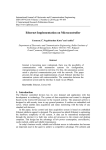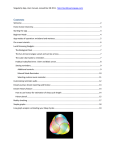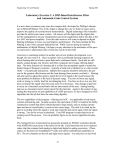Download NeuroDreamer User`s Manual for Lucid
Transcript
Welcome! Your NeuroDreamer™ sleep mask is the result of our years of research, study, and development — all with the goal of helping you get the rest you want. Your NeuroDreamer sleep mask can help you experience the joy of deep relaxation. On a plane, on a break from work, or at night in your bed. Listen to the serenity, and drift into your dreams... To help you dream more easily, this comfortable sleep mask can generate soothing sounds and fading lights embedded with brainwaves corresponding to a person going to sleep. To help you dream the dreams you want to dream, we created this Lucid Dreaming version of the NeuroDreamer sleep mask. Lucid Dreaming is the ability to make conscious choices in your dreams. Through light and sound, your NeuroDreamer sleep mask will give you opportunities to know that you are dreaming—while you are dreaming. Once you are aware you are dreaming, you can make choices. What choices will you make? Quick Start Guide You will see a preview of your Lucid Dreaming cue 1. To keep the NeuroDreamer sleep mask comfortable, affordable, and easy to use while resting, it was designed with three buttons. Most features of the sleep mask are accessed with a simple push of one button. (The default settings for the Lucid Dreaming session should work well for most people: 4 hours of silence, followed by a visual cue every 20 minutes, and continuing for 8 hours.) 2. Top button: play a Sleep song 2, followed by a Lucid Dreaming session. Although your NeuroDreamer sleep mask is very easy to use, we want you to receive the maximum benefit from it, and we highly recommend that you read this entire User’s Manual before using your NeuroDreamer sleep mask for the first time. There are two Sleep songs to choose from: the first song is musical, and the second is an ambient ocean sound. Try pressing the top button again to listen to each song and see which one you like the best. If you are listening to the ambient ocean song, pressing the top button again will turn your NeuroDreamer sleep mask off. Please see the last section of this User Manual for an important warning/disclaimer. If you would like to jump right in and start using your NeuroDreamer sleep mask, here is what to do: ■■ ■■ ■■ Charge the battery of your NeuroDreamer sleep mask (see Battery Charging Instructions later in this manual). Wrap the NeuroDreamer sleep mask around your head and adjust it so that it is comfortable. If you would like an alarm to sound at the end of your Lucid Dreaming session, press the bottom button twice and wait for the red light to turn off. (The default setting for the alarm is 8 hours.) –– The red light will turn on. –– You will hear the alarm for a short burst. –– You will hear a few musical notes. –– The red light will turn off. ■■ You can start a Lucid Dreaming session in one of two ways: 1. Middle button: start a Lucid Dreaming session (without a Sleep song). 2 ■■ ■■ Pressing the middle button while you are listening to one of the Sleep songs will change the loudness of the sound. There are three loudness settings: High, Medium, and Low. Pressing the bottom button while you are listening to a Sleep song will change the brightness of the fading lights. Try pressing this button after a song has been playing for about 10 seconds. You will see the brightness of the lights change. There are four brightness levels: High, Medium, Low, and Off. Once your NeuroDreamer sleep mask finishes the Lucid Dreaming session, it will remember all of your settings the next time you use it — simply press the top or middle button to begin. More information is available on the FAQ page of the NeuroDreamer website: http://www.NeuroDreamer.com 1. A cue is a sequence of pulsing lights or sounds that will remind you that you are dreaming—while you are dreaming. 2. A Sleep song will gently guide you into a restful state through a sequence of brainwave frequencies embedded in beautiful sounds and fading lights. 3 Lucid Dreaming We are asleep. Our life is a dream. But we wake up, sometimes, just enough to know that we are dreaming. — Ludwig Wittgenstein It does help to have conscious intent to lucid dream. One way to increase your intent is to keep a dream journal. Writing down your dreams also increases the chance that you will remember your dreams. And reading your dream journal before you go to sleep reinforces your intent to lucid dream. Why is it rare for dreamers to be aware that they are dreaming? It is not known. But it is known that people can learn to become aware that they are dreaming while in their dreams. This is lucid dreaming. And it can be empowering. If you remember your dreams, you become more aware of them. This awareness makes it much easier to know you are dreaming while in a dream. Knowing you are dreaming while dreaming is an important first step in lucid dreaming. Consider: what is the difference between waking life and dreaming life? They seem very different, but both involve experiencing a perceived world. In waking life, the perceived world is heavily influenced from our external sensory input. In dreaming life, with very little external input, the perceived world comes mainly from inside, where we are not constrained by the laws of physics, and where we are less influenced by social constraints. The NeuroDreamer sleep mask has features that can help you achieve lucid dreaming. One of the main features is Lucid Dreaming cues. After you start a Lucid Dreaming session, it will play Lucid Dreaming cues every so often (which you can configure to your taste). These cues consist of lights (by default), but can also be configured to consist of sound instead. If a cue is played while you are dreaming, you have the ability to perceive the cue in your dream, and thus have an opportunity to become aware that you are dreaming. (Though the default settings for the Lucid Dreaming cues are good for most people, you may need to experiment with the configurations so that the cues are strong enough to pervade your dreams, but not so much that they wake you up—this is explained later in this User’s Manual.) The lack of these constraints creates a safe environment for exploring new possibilities in our lives, since the consequences of our choices disappear when we awaken. Yet, as with waking life, you can learn to remember and learn from the consequences of your choices. And you can then use what you learn to make new choices. This is powerful stuff! You can, if you choose to, make use of lucid dreaming to improve your life. Lucid dreaming, as with any skill, takes motivation, practice, and intent. Your opportunities for lucid dreaming also improve greatly with the ability to remember your dreams. If you are reading this User’s Manual, you probably have the necessary motivation. This will enable you to put in the time for practice. 4 According to Stephan LaBerge, a prominent lucid dreaming researcher, dream periods get longer and closer together as the night proceeds. So, to lucid dream well, it is important to get good sleep. You can use your NeuroDreamer sleep mask to play one of its two Sleep songs at the beginning of a Lucid Dreaming session. This may help you get into a better mood for sleeping well. 5 LaBerge also notes that if you interrupt your sleep for 30 to 60 minutes, this greatly increases your likelihood of lucid dreaming. Some good things to do in this period of interrupted sleep are: write dreams in your dream journal, read dreams from your dream journal, or read about lucid dreaming—anything that reinforces your intent to become aware of your dreams. You can use your NeuroDreamer sleep mask’s alarm function to wake up during a dream. You can experiment with the alarm time, but a good place to start might be 5 hours, about when your dreams are getting longer and more frequent. (Alarm settings are explained later in this User’s Manual.) Once awake, it helps to remain very still, and think about the details of your dream. Once you have reviewed the entire dream the best you can, it helps to write it down in your dream journal right away (since you may forget it if you go back to sleep). Write down your dreams in your dream journal, no matter how much or how little you recall of your dream. Over time, you should find yourself remembering more of your dreams. And eventually, you may find that you are aware that you are dreaming—while you are dreaming! The more this happens, the more opportunities you will have to make conscious choices in your dreams. With enough practice, you may be flying to your favorite destinations, hanging out with awesome characters, learning more about yourself, improving your life, and changing your world. that you will start lucid dreaming when you do. Of course, the Lucid Dreaming cues from your NeuroDreamer sleep mask are great dreamsigns! Preview the Lucid Dreaming cue before going to sleep, and pay close attention to it. (You can preview the Lucid Dreaming cue by pressing the middle button when the sleep mask is powered off.) You can also ask yourself throughout the day, “Am I dreaming?” Ask this question frequently. Ask it while falling asleep. Intend to ask it while dreaming. And definitely ask it when you notice a dreamsign in your dreams. Make an intention to perform some action when you become aware that you are dreaming. In the Carlos Castaneda books, he recommended something simple, such as looking at your hands. If you can do that, then you can do anything! Here is a procedure recommended by LaBerge: 1. Before you go to sleep, tell yourself that you will wake up from your dreams and remember them. 2. When going back to sleep, become fixed on the notion that you will be aware, while dreaming, that you are dreaming. 3. Visualize yourself lucid dreaming. Repeat steps 2 and 3 until you fall asleep. Some tips for increasing your lucid dreaming: After writing down your dreams for awhile, you should become aware of aspects of your dreams that differ from your waking life. You can use them as signs that you are dreaming. LaBerge calls these dreamsigns. You can reinforce your intent by telling yourself before you go to sleep that you will recognize your dreamsigns, and 6 7 Basic Details for Operating your NeuroDreamer™ Sleep Mask We want you to Lucid Dream! The Lucid Dreaming version of the NeuroDreamer sleep mask comes with default settings that work well for most people, allowing you, with practice, to become aware of your dreams while you are dreaming. This section assumes these default settings. The Lucid Dreaming settings can be customized specifically for your tastes (as described later in this User’s Manual). The NeuroDreamer sleep mask is designed to be worn over your eyes and ears. To use it, you should first place yourself in a comfortable position, lying or sitting down. Wrap the mask around your head, with the printed design side of the fabric facing out, and the zipper facing up. The eye indentations on the inside of the mask should be covering your eyes. Lightly pull the ends of the NeuroDreamer sleep mask around to the back of your head and attach them using the built-in Velcro straps. Adjust the NeuroDreamer sleep mask so that it feels comfortable. There are three buttons arranged in a vertical column along the right temple on the outer side of the NeuroDreamer sleep mask. These are for operating the NeuroDreamer sleep mask. In the instructions that follow, these buttons will be referred to respectively as the “top button”, the “middle button”, and the “bottom button”. If an instruction states that you should press a user button, it means that you should press it briefly, and then let it go. Enabling the Alarm The bottom button can be used to enable the alarm, which is intended to wake you up. The default alarm time is 8 hours after starting a session on your NeuroDreamer sleep mask. To enable the alarm, press the bottom button twice. You will hear the alarm 8 for a short burst, followed by a few musical notes, and the red light will turn off. You can then start a Lucid Dreaming session with your NeuroDreamer sleep mask. (You can change the alarm settings, as described later in this User’s Manual.) Starting Your Lucid Dreaming Session Pressing the middle button starts your Lucid Dreaming session (without playing a Sleep song). The default settings for Lucid Dreaming should work well for most people—after 4 hours of silence the NeuroDreamer sleep mask will play a visual cue every 20 minutes—the cue should pervade your dreams without waking you up, giving you a chance to control your dreams. After a total of 8 hours the Lucid Dreaming session ends, and your NeuroDreamer sleep mask turns itself off. (You can change the Lucid Dreaming settings, as described later in this User’s Manual.) Playing a Sleep Song* The top button is used for playing and selecting a Sleep song before your Lucid Dreaming session. There are two Sleep songs to choose from: the first song is musical, and the second song is an ambient ocean sound. By pressing this button, the NeuroDreamer sleep mask turns on, and the first Sleep song is selected. By pressing it again, the ambient ocean Sleep song is selected. (Pressing it one more time turns off the NeuroDreamer sleep mask, as described below.) The NeuroDreamer sleep mask will remember which song you selected, so that this song will be the first one selected by the top button the next time you use the NeuroDreamer sleep mask. After the Sleep song finishes, the Lucid Dreaming session starts (as described above). * As stated earlier, a Sleep song will gently guide you into a restful state through a sequence of brainwave frequencies embedded in beautiful sounds and fading lights. 9 Adjusting the Light intensity for a Sleep Song The Light intensity can be adjusted while a Sleep song is playing by pressing the bottom button. There are four preset Light levels: High, Medium, Low, and Off. By pressing this button the Light intensity is adjusted down one level. If the intensity is already Off, it will adjust to High. Note that a song must be playing for the Light intensity to be adjusted. The NeuroDreamer sleep mask will remember which Light intensity you selected, so that this Light intensity will be used the next time you play a Sleep song. Adjusting the Sound Volume for a Sleep Song The volume level can be adjusted while a Sleep song is playing by pressing the middle button. There are three preset volume levels: High, Medium, and Low. Each time you press the middle button the volume will be adjusted down one level. If the volume is already Low, it will be adjusted to High. Note that a song must be playing for the volume to be adjusted. The NeuroDreamer sleep mask will remember which volume level you selected, so that this volume level will be used the next time you play a Sleep song. Turning Off the NeuroDreamer Sleep Mask The NeuroDreamer sleep mask will turn itself off automatically after the Lucid Dreaming session has ended. A complete Sleep song lasts 20 minutes, with the Lucid Dreaming session continuing afterward. If you would like to turn off the NeuroDreamer sleep mask before the Sleep song or the Lucid Dreaming session has ended, press the top button until the ambient ocean Sleep song is reached, and then press the top button one more time. Charging the Battery To recharge the internal battery please do the following: 1.Unzip the zipper running along the top of the NeuroDreamer™ sleep mask. 2.Locate the connector for the battery charger. This is the black cylindrical plug on a short cord in the middle of the NeuroDreamer sleep mask. 3.Connect the battery charger’s cord to the NeuroDreamer sleep mask’s connector. 4.Plug the battery charger into an AC power outlet. 5.Allow 3 to 5 hours for a full charge. 6.Unplug the battery charger from the power outlet. 7.Gently disconnect the battery charger from the plug on the NeuroDreamer sleep mask. Take care not to pull on the cord, or you may damage the NeuroDreamer sleep mask. 8.Slip the cord and plug back into the NeuroDreamer sleep mask. 9.Zip up the NeuroDreamer sleep mask. Your NeuroDreamer sleep mask is now ready for use. Note: Do not attempt to use the NeuroDreamer sleep mask while it is being recharged. It will automatically turn off if you do so. IMPORTANT: To preserve the battery life of the NeuroDreamer sleep mask be sure to charge it at least once every three months. NOTE: Your NeuroDreamer sleep mask will remember all of your settings the next time you use it. 10 11 Washing and Care of Your NeuroDreamer Sleep Mask Tips on Using Your NeuroDreamer Sleep Mask Your NeuroDreamer sleep mask comes with a soft, washable, cotton cover. In addition to providing Lucid Dreaming cues, the Sleep songs in the NeuroDreamer sleep mask are designed to help improve your patterns of rest. The fabric cover of the sleep mask should be dry-cleaned only. Do not get the fabric cover wet. Never put it in a washing machine. Under no circumstances should the enclosure which contains the electronics be washed, either separately or while inside the fabric sleeve. To dry-clean the fabric cover: 1.Gently unzip the cover at the top of the sleep mask. 2.Gently detach the Velcro surrounding the three buttons from the cotton cover. 3.Gently remove the foam inside of the mask from the cotton cover. 4.Dry-clean the fabric cover. 5.Gently re-insert the insides of the sleep mask, making sure to align and attach the Velcro surrounding the three buttons. 6.Gently zip up the cover. Under no circumstances should the enclosure which contains the electronics be dry-cleaned, either separately or while inside the fabric sleeve. Using the Sleep songs in your NeuroDreamer sleep mask will give you the best results if you only use it when you feel like relaxing. Using it at other times may create associations with wakefulness that will adversely affect your sleep mask’s effectiveness. Some people may find that their rest patterns change for the better the first time they use the Sleep songs in their NeuroDreamer sleep mask. For some, this may come in degrees with repeated use. For example, you may rest easier than before; you may wake up in the night less frequently; and the duration of your rest periods may be longer. When using the Sleep songs, you should not expect them to take effect immediately. The NeuroDreamer sleep mask is designed to help improve your patterns of rest gradually. Is the NeuroDreamer Sleep Mask for Everyone? Not everyone, no. Not many things are. But a NeuroDreamer sleep mask may be helpful for you. Research has shown that entrainment devices, such as the NeuroDreamer sleep mask, work for about 70% of people tested. Even if you are not in that majority, you may benefit from the comfortable memory foam sleep mask that filters out light and absorbs external sound. You may also enjoy the soothing, restful effects of the NeuroDreamer sleep masks beautiful sounds. Many people would like the ability to control their dreams. This ability is second nature to some. Most, however, find it takes a lot of practice. The Lucid Dreaming cues provided by the NeuroDreamer 12 13 sleep mask are intended to aid in this practice. Even though it can be fun and rewarding, it is up to you to provide the necessary intent and practice. There is a small subset of people who are sensitive to blinking lights, and perhaps even to brainwave frequencies embedded into sound. Many devices and environments that use blinking lights, including strobe lights, cameras, disco lights, TVs, and NeuroDreamer sleep mask, MAY CAUSE SEIZURES in this subset of people. Please read the final section of this User’s Manual for the complete WARNING and disclaimer... How the NeuroDreamer Sleep Songs Work As well as being a Lucid Dreaming aid, the NeuroDreamer sleep mask is also an entrainment 3 device. For its Sleep songs, it generates a sequence of brainwave frequencies that correspond to the natural sequence of brainwave activity as observed in a person as they fall asleep. These frequencies are produced using binaural beats 4 embedded within pleasing sounds, and synchronized with fading lights — all generated by the NeuroDreamer sleep mask’s microcontroller. The Sleep songs of the NeuroDreamer sleep mask are an advancement over prior entrainment devices which attempt to entrain the brain with a single brainwave frequency at a time. The NeuroDreamer sleep mask uses up to four brainwave frequencies simultaneously (mixed at different amplitudes), to more closely replicate the full spectrum of frequencies present in a person who is falling asleep. 3. “Entrainment” is the process of externally presenting brainwave frequencies to the brain, allowing it to follow along to those frequencies. 4. A “binaural beat” refers to the frequency that is perceived when two tones that are close together in pitch are played in each ear. 14 In addition to binaural beats, the NeuroDreamer sleep mask’s second Sleep song utilizes another method for audio entrainment. An ambient ocean sound, somewhat like ocean surf, is played in both ears, but with a slight time delay (called “phase shift”) in one ear. By changing the length of the time delay, the brain perceives the surf sound as moving between the ears. The rate of this perceived movement is used for entrainment. This Sleep song may be better for some people, and it may also mask out external sounds in noisy environments, such as airplanes or loud neighbors. Lucid Dreaming Session Settings, and How to Change Them Introduction to Lucid Dreaming Sessions and Cues The NeuroDreamer sleep mask comes with default settings for Lucid Dreaming sessions that work well for most people. But with NeuroDreamer sleep mask, you have a lot of control over your Lucid Dreaming session’s parameters, making the NeuroDreamer sleep mask a very powerful tool for helping you achieve Lucid Dreaming. There are many reasons that you might want to change the Lucid Dreaming sessions from their default settings. You may want to make the cues stronger, or weaker, to make it more likely that the Lucid Dreaming cues pervade your dreams without waking you up. You may want to change the timing on when the Lucid Dreaming cues occur, or how long they play. You may want to set an alarm, and change its time. You may want to change the aesthetics of the cues to your personal taste. This is all possible with the Configuration Menus that will be described in this section. Before getting into how to change the settings for Lucid Dreaming sessions, you will need to be familiar with some terminology. 15 Sleep Song: A Sleep song will gently guide you into a restful state through a sequence of brainwave frequencies embedded in beautiful sounds and fading lights. There are two Sleep Songs to choose from in the Lucid Dreaming version of the NeuroDreamer sleep mask: one that is musical, and one that is ambient ocean. Both are 20 minutes long. Lucid Dreaming cue: A cue is a sequence of pulsing lights or sounds that will remind you that you are dreaming—while you are dreaming. Lucid Dreaming session: To define a Lucid Dreaming session, let’s start by looking at the timeline in Figure A, which shows a typical Lucid Dreaming session. Figure A illustrates a typical Lucid Dreaming session. The top line shows the timeline for the session. A Lucid Dreaming session always lasts for 8 hours, or until the optional alarm sounds. If the session is started via the top button, then a Sleep song (with embedded binaural beats and synchronized lights) is played for the first 20 minutes of the Lucid Dreaming session. If the session is started via the middle button, then no Sleep song is played during the first 20 minutes. In this example the first Lucid Dreaming cue has been configured to start 4 hrs and 20 minutes into the session. After the optional Sleep song, and before the first cue, you will hear no sound, and see no lights. The timing of the cues is shown on the second line of Figure A. In between each cue, you again will hear no sounds and see no lights. In this example, a cue is played every 20 minutes until 8 hours has expired, or until the alarm sounds. In the example in Figure A, the alarm time is configured for 7 hours from the start of the session. If the alarm was not enabled before starting the Lucid Dreaming session, cues will continue every 20 minutes for the complete 8 hours, and the sleep mask will power itself off. If the alarm was enabled before starting the Lucid Dreaming session, then the alarm will sound at the 7 hour mark, the sleep mask will power itself off, and no further cues will be played. Figure A: Timeline of a Typical Lucid Dreaming Session 16 17 User Interface: The Main Menu The basic functionality of The Main Menu of the Lucid Dreaming version of the NeuroDreamer sleep mask has already been explained. Here’s a recap: Figure B: Timeline of a Typical Lucid Dreaming Cue Figure B illustrates a typical Lucid Dreaming cue. (Remember that a cue is what is played every 20 minutes in the typical Lucid Dreaming session shown in Figure A.) A cue is defined by configuring a rep, the rep duration, the rep spacing, and the cue duration. A cue is composed of a series of reps (this example has a cue consisting of a series of 5 reps). A rep can either consist of lights fading in and out, or the sounding of a chord (depending on whether you have selected visual or audio cues—how to select this will be explained a little later). The rep duration is configurable. In the example above the rep duration has been set at 1 second. Reps are separated from each other by a space, or period of time in which no lights are fading or chords sounding. This rep spacing is configurable as a multiple of the rep duration. In the example above the rep spacing has been set at 3x, resulting in a 3 second space between reps (since 3 times 1 second equals 3 seconds). Reps will continue, one after another, each followed by the rep spacing, until the cue duration is over. The cue duration is the entire length of time of the cue. The cue duration is configurable—in this example the cue duration has been configured at 20 seconds, resulting in a cue composed of 5 reps in total. 18 When the sleep mask is off, pressing the bottom button twice will enable the alarm, which is intended to wake you up after a period of time. After the alarm sounds, the sleep mask powers itself off. When the sleep mask is off, pressing the middle button will start a Lucid Dreaming session (without a Sleep song), consisting of Lucid Dreaming cues, for up to 8 hours (or until the alarm sounds), after which the sleep mask will power itself off. When the sleep mask is off, pressing the top button will start a Lucid Dreaming session, beginning with a 20-minute long Sleep song, and continuing with the Lucid Dreaming session, consisting of Lucid Dreaming cues, for 8 hours (or until the alarm sounds), after which the sleep mask will power itself off. While the Sleep song is playing, pressing the top button again will advance to the second Sleep song (and pressing it again will turn the sleep mask off), pressing the middle button will change the volume, and pressing the bottom button will change the intensity of the lights. Please note, when the Lucid Dreaming session is between the playing of cues the sleep mask will appear to be “off” (since there are no sounds and no lights in between cues). The Main Menu has a few additional button combinations that can initiate an action. These are summarized in the chart of the Main menu on the following page. In this chart, the graphics on the left-hand side depict button or button combinations that will initiate an action. To the right of the graphics is a description of what action will be taken in response to the button(s) being pressed. For 19 example, the third entry in the chart shows that pressing the bottom button by itself will activate the Alarm menu. The fourth entry in the chart shows that pressing the top and middle buttons together will activate the Cue menu. The text within parentheses following a menu name summarizes the features configured by that menu, once it has been activated. The Main menu is available whenever the mask is off, or at any time during the Lucid Dreaming session (including while a cue is playing)—except the Main menu is not available when a Sleep song is playing. (The Main menu is also not available when a Configuration Menu is active.) If the Main menu is accessed during a Lucid Dreaming session (including while a cue is playing) the current Lucid Dreaming session is terminated. Main Menu Start Lucid Dreaming Session [with a Sleep Song]* Start Lucid Dreaming Session [without Sleep Song]* ** Alarm Menu (Time to Alarm, Enable Alarm) Audio-Visual Menu (Volume/Brightness, Audio/Visual Cues) Session Menu (Time to 1st Cue, Start Lucid Nap) *A note on the two Start Lucid Dreaming Session buttons: If the alarm has been enabled it will sound briefly before the Sleep song or session begins. If you hear the alarm, but you do not wish the alarm to sound and wake you up later, you can press the bottom button once, and wait a few seconds for the red light to turn off, after which you can once again press one of the two Start Lucid Dreaming Session (top or middle) buttons. **A note on the Start Lucid Dreaming Session [without Sleep Song] button: In addition to starting a Lucid Dreaming session, the middle button also immediately plays a single cue. This serves two purposes: 1), it lets you acclimate to the cue you will try to find while you are dreaming; 2), it doubles as a handy ‘review cue’ button. Use it to review what a cue is like after changes have been made to it via the Cue Menu or Audio-Visual Menu. Intro to the Four Configuration Menus There are four configuration menus that can be accessed from the main menu: ■■ Alarm Menu ■■ Session Menu ■■ Audio-Visual Menu ■■ Cue Menu Each will be explained in its own section, and we will give you examples on how to change settings for each. Cue Menu (Rep Duration, Rep Spacing, Cue Duration) 20 21 These configuration menus allow you to configure various features (or “parameters”) of the Lucid Dreaming session. By pressing buttons while a menu is active, the values of specific parameters can be changed, as described in the pages that follow. All the configuration menus share the following common characteristics: Each Configuration Menu has its own Home Color When a configuration menu is accessed, a colored light—specific to that menu—will be turned on to indicate that the menu is active. If you do not press any buttons for several seconds, the light will turn off, indicating the menu is now inactive. For example, when the Alarm menu is accessed you will see the red light turned on, and it will remain on until the Alarm menu is no longer active. Configuration Menu Home Color Alarm Menu Red Session Menu Blue Audio-Visual Menu Yellow Cue Menu Green Please review the menu charts on the following pages. You will see that each chart contains a box of four squares in the upper right corner, one of which is has the name of a color. This is the home color for that menu. The Audio-Visual menu is a special case: notice it has two boxes. Its home color is yellow. When visual cues are in effect, all of the other colored lights are also turned on so that you can see their intensity while changing the brightness parameter. Once accessed, a Menu remains active until no buttons have been pressed for several seconds 22 You will know that the menu is no longer active once its home color is turned off. This happens automatically after no buttons are pressed for several seconds. If a parameter is not changed while its Menu is active, it will keep the value it had before the Menu was accessed After its Menu is accessed the initial change made to a parameter will reset its value to zero. Subsequent changes made to the parameter while the Menu is active will be cumulative. For example, if the Alarm menu is accessed, and then the top button is pressed (add one hour to the alarm time), the alarm time will first be reset to zero, and then increased to one hour. Pressing the top button a 2nd time will add another hour to the alarm time, and so on. Do-Re-Mi Feedback When a configuration menu ends (i.e., stops being active), a musical scale may be played in one or both ears, to provide the user with feedback on what the current values for that menu’s parameters are. Do-Re-Mi Feedback on the Alarm Time Do-Re-Mi feedback happens when the alarm time is changed in the Alarm menu (which will be explained soon). This alarm time parameter can range from 20 minutes to 8 hours. When the Alarm menu ends, the notes of a musical scale will be played in the left ear—one note for each hour in the alarm time. Then musical notes will be played in the right ear—one note for each additional 20 minutes in the alarm time. For example, assume the current value for the alarm time is 5 hours, 40 minutes. In this case, as the Alarm menu ends, the musical notes “Do Re Mi Fa So” will be played in the left ear, followed by the notes “Do Re” in the right ear. 23 Do-Re-Mi Feedback on the 1st Cue Time The Do-Re-Mi feedback will happen when the 1st cue time is changed in the Session menu (which will be explained soon). This 1st cue time parameter can range from 20 minutes to 8 hours. When the Session menu ends, the notes of a musical scale will be played in the left ear—one note for each hour in the 1st cue time. Then notes will be played in the right ear—one musical note for each additional 20 minutes in the 1st cue time. For example, assume the current value for the 1st cue time is 6 hours. In this case, as the Session menu ends, the notes “Do Re Mi Fa So La” will be played in the left ear. Using the Alarm Menu The NeuroDreamer sleep mask comes equipped with a programmable alarm that will wake you at a time of your choosing. This time is measured from the start of the Lucid Dreaming session. (If a Sleep song is played at the beginning of the session, then the alarm time is measured from the start of the Sleep song.) Enabling the Alarm From the Main menu, press the bottom button to activate the Alarm menu. The Alarm menu’s home color of red is turned on. Now press the bottom button again. This enables the alarm. The alarm sounds for a fraction of a second to let you know that it is enabled. This is followed by a “Do-Re-Mi” scale which lets you know what the current alarm time is (as described in the section above). Then the Alarm menu is exited after waiting a few seconds (and the red light is turned off). The alarm remains dormant until the next session is started. It will then automatically go off at the programmed time, as measured from the beginning of the session. 24 During the session, when the alarm sounds, it can be turned off by pressing any button. Otherwise it will automatically turn itself off after 30 seconds. Once turned off the alarm is no longer enabled. It must be explicitly re-enabled before the next session in which you want to use it. Setting the Alarm Time From the Main menu, press the bottom button to activate the Alarm menu. The Alarm menu’s home color of red is turned on. You can now set the alarm time by using the top and middle buttons. Pressing the top button adds 1 hour to the alarm time. Pressing the middle button adds 20 minutes to the alarm time. When finished setting the alarm time, wait for the Alarm menu’s home color to turn off. A “Do-Re-Mi” scale will play briefly to let you know what the alarm time is (as described in the section above). The NeuroDreamer sleep mask remembers your alarm time setting. Unless you want to change the current setting, you do not have to set the alarm time before each use. Disabling the Alarm Once enabled, the alarm automatically disables itself the next time the alarm sounds. The alarm is also disabled upon activating the Alarm menu. So, if you change your mind after enabling the alarm (and before starting a session), or if you are not sure what the state of the alarm is (maybe a friend or family member who uses the mask enabled the alarm but did not run a session) you can always be sure it is disabled by simply activating the Alarm menu and then letting the menu exit of its own accord (because no further buttons are pressed for several seconds while the home color of red is on). 25 Alarm Menu Add 1 Hour to Alarm Time Add 20 Minutes to Alarm Time Enable Alarm Examples using the Alarm Menu The Alarm menu is accessed from the Main Menu, which is active at any time when a sleep song is not playing, and no configuration menu is active. Set the alarm time to 5 hours and 40 minutes: From the main menu press the bottom button. The Alarm menu’s home color of red will turn on. Press the top button five times (for 5 hours), and the middle button two times (for 40 minutes). Wait a few seconds. The scale “Do-Re-Mi-Fa-So” will be played in the left ear, “Do-Re” will be played in the right ear, and the red home color will turn off. The next time you start a Lucid Dreaming session (with or without a Sleep song), the alarm will sound 5 hours and 40 minutes after you start the session. 26 Set the alarm time to 7 hours: From the main menu press the bottom button. The Alarm menu’s home color of red will turn on. Press the top button seven times (for 7 hours). Wait a few seconds. The scale “Do-Re-Mi-Fa-SoLa-Ti” will be played in the left ear, and the red home color will turn off. The next time you start a Lucid Dreaming session (with or without a Sleep song), the alarm will sound 7 hours after you start the session. Using the Session Menu The Session menu allows you to set the time to the 1st cue. It also supplies a handy shortcut for starting a lucid “nap” session (which will be described, below), without disturbing the settings used for the normal Lucid Dreaming session. Setting the time to the 1st Cue From the Main menu, press the middle and bottom buttons together to activate the Session menu. The Session menu’s home color of blue is turned on. You can now set the time to the 1st cue by using the top and middle buttons. Pressing the top button adds 1 hour to the time to 1st cue. Pressing the middle button adds 20 minutes to the time to 1st cue. When finished setting the time, wait for the Session menu’s home color to turn off. A “Do-Re-Mi” scale will play briefly to let you know what the time to the 1st cue is (as described earlier). Starting a Lucid Nap Session From the Main menu, press the middle and bottom buttons together to activate the Session menu. The Session menu’s home color of blue is turned on. Press the bottom button. The Session menu’s home color will be turned off, and a cue will immediately be played—this lets you know that the Lucid Nap session has started. 27 In a Lucid Nap session, cues will be played at 20 minutes, at 40 minutes, and at 1 hour, after which the alarm will sound. This does not disturb the currently saved settings for the 1st cue and alarm times. The next time a Lucid Dreaming session is started, the normal settings will be used. (The Lucid Nap session timing cannot be changed, but is fixed at these values.) A strategy for maximizing your Lucid Dream recall By using the lucid nap feature together with the normal Lucid Dreaming session, you may be able to remember more of your dreams. For instance, set the 1st cue time to 4 hours, and the alarm time to 5 hours. Enable the alarm and start a session. After 5 hours the alarm will sound. When you awaken you may remember dreams you had in the last hour or so. You may want to write them down in a dream journal (which is highly recommended). Some research has shown that staying awake for 30 to 60 minutes before going back to sleep greatly enhances the probability of achieving Lucid Dreams. When you are ready, put the mask back on and start a lucid nap by pressing the middle and top buttons together ”Session Menu”), followed by the bottom button (“Start Lucid Nap”). Go back to sleep until the mask wakes you in another hour. Repeat the process as many times as you like in a night. Session Menu Add 1 Hour to 1st Cue Time Add 20 Minutes to 1st Cue Time Start Lucid Nap Session Examples using the Session Menu The Session menu is accessed from the Main Menu, which is active at any time when a sleep song is not playing, and no configuration menu is active. Change the time to the 1st Lucid Dreaming cue to 3 hours and 20 minutes: From the main menu press the middle and bottom buttons together. The Session menu’s home color of blue will turn on. Press the top button three times (for 3 hours), and the middle button once (for 20 minutes). Wait a few seconds. The scale “Do-Re-Mi” will be played in the left ear, “Do” will be played in the right ear, and the blue home color will turn off. The next time you start a Lucid Dreaming 28 29 session (with or without a Sleep song), the 1st Lucid Dreaming cue will occur 3 hours and 20 minutes from when you start the session. Start a Lucid Nap session: From the main menu press the middle and bottom buttons together. The Session menu’s home color of blue will turn on. Press the bottom button. The Session menu’s home color will be turned off, and a cue will immediately be played—this lets you know that the lucid nap session has started (and a Lucid Dreaming cue will be played at 20 minutes, at 40 minutes, and at 1 hour, after which the alarm will sound). As stated earlier, starting a Lucid Nap does not disturb the currently saved settings for the 1st cue and alarm times—the next time a Lucid Dreaming session is started, the normal settings will be used. Adjusting the Cue Volume / Brightness From the Main menu, press the top and bottom buttons together to activate the Audio-Visual menu. The Audio-Visual menu’s home color of yellow is turned on. If the current cue type is visual, the other three colors are also turned on. If the current cue type is audio, a chord will sound. You can now adjust the cue volume / brightness by using the top and middle buttons. Pressing the top button increases the volume / brightness. Pressing the middle button decreases the volume / brightness. These changes will be reflected in the intensity of the home color(s) and the volume of the chord (if it is sounding). There are seven volume / brightness levels. It is important to set volume and brightness levels that are right for you. Using the Audio-Visual Menu The Audio-Visual menu is used to select the type of cue: audio or visual. The menu is also used to adjust the volume or brightness of the cue. The audio-visual levels should be set low enough that the cues will not awaken you, but high enough that the cues will pervade your dreams. You may need to experiment to get the settings you like. Selecting Audio or Visual Cues From the Main menu, press the top and bottom buttons together to activate the Audio-Visual menu. The Audio-Visual menu’s home color of yellow is turned on. If the current cue type is visual, the other three colors are also turned on. If the current cue type is audio, a chord will sound. You can now switch the cue type by pressing the bottom button. The home color(s) and chord (or no chord) will change to reflect the new cue type. If you press the bottom button again, the cue type will be switched back. After the home color of yellow turns off, you can review your entire cue to see if you like it. Pressing the middle button will play your cue for you (and also starts the Lucid Dreaming session). If you don’t like it, you can change your cue again via the configuration menus (this will terminate your Lucid Dreaming session). 30 Review your cue to see if you like it. 31 Audio-Visual Menu off, and an audio chord will sound. Wait a few seconds for the yellow home color to turn off. The Lucid Dreaming cues are now set to audio (giving you a chance to have musical chords affect your dreams). or (when current cue is visual) (when current cue is audio) Increase Volume / Brightness Decrease Volume / Brightness Toggle Audio / Visual Cues Examples using the Audio-Visual Menu The Audio-Visual menu is accessed from the Main Menu, which is active at any time when a sleep song is not playing, and no configuration menu is active. Change from a visual Lucid Dreaming cue to an audio Lucid Dreaming cue: From the main menu press the top and bottom buttons together. The Audio-Visual menu’s home color of yellow, along with the other three colors, will turn on. Press the bottom button to toggle the cue type to audio. All but the Audio-Visual menu’s home color of yellow will turn 32 Change from an audio Lucid Dreaming cue to a visual Lucid Dreaming cue: From the main menu press the top and bottom buttons together. The Audio-Visual menu’s home color of yellow will turn on, and an audio chord will sound. Press the bottom button to toggle the cue type to visual. The other three colors will turn on, and the audio chord will stop. Wait a few seconds for the colored lights to turn off. The Lucid Dreaming cues are now set to visual (giving you a chance to have blinking lights affect your dreams). Change the visual cue brightness to the dimmest level: If you are using visual Lucid Dreaming cues, and find that the lights tend to wake you up, you can try making them dimmer. This is how to set the lights to their dimmest setting: From the main menu press the top and bottom buttons together. The Audio-Visual menu’s home color of yellow, along with the other three colors, will turn on. Each time you press the middle button the brightness level will be decreased (and the colored lights will grow dimmer). When the colored lights no longer grow dimmer in response to pressing the middle button you have reached the dimmest level. Wait for the yellow home color to turn off. The next time you start a Lucid Dreaming session, your visual Lucid Dreaming cues will shine at their dimmest setting. 33 Using the Cue Menu The Cue menu is used to set the rep duration, the spacing between reps, and the cue duration. Setting the Rep Duration From the Main menu, press the top and middle buttons together to activate the Cue menu. The Cue menu’s home color of green is turned on. Use the top button to select between five different rep durations: ¼ second, ½ second, 1 second, 2 seconds, and 3½ seconds. For instance, to set the rep duration to 1 second, press the top button 3 times. Setting the Spacing between Reps From the Main menu, press the top and middle buttons together to activate the Cue menu. The Cue menu’s home color of green is turned on. Use the middle button to select between three different rep spacings: 1x, 2x, and 3x. These spacings are multiples of the rep duration. For instance, if the rep duration is 2 seconds, to set the spacing between reps to 4 seconds, press the middle button twice (since 2 seconds times 2 equals 4 seconds). session). If you don’t like the results, you can activate the Cue Menu, and repeat the process until the cue is to your liking. Cue Menu + Rep Duration (1/4 sec, ½ sec, 1 sec, 2 secs, 3 ½ secs ) + Rep Spacing (1x, 2x, 3x multiple of Rep duration ) + Cue Duration (10, 20, 30 secs ) Setting the Cue Duration From the Main menu, press the top and middle buttons together to activate the Cue menu. The Cue menu’s home color of green is turned on. Use the bottom button to select between three different cue durations: 10 seconds, 20 seconds, and 30 seconds. Example using the Cue Menu The Cue menu is accessed from the Main Menu, which is active at any time when a sleep song is not playing, and no configuration menu is active. Use the Session button on the Main menu to review your changes The best way to review the changes you have made is to wait for the Cue menu’s home color to turn off, and then press the middle button (“Start Lucid Dreaming Session [without Sleep Song]”), which will immediately play a cue (and it will also start a Lucid Dreaming Change the Lucid Dreaming cue duration to 30 seconds: From the main menu press the top and middle buttons together. The Cue menu’s home color of green will turn on. Press the bottom button 3 times (for 30 seconds). Wait a few seconds. The green home color will turn off. The next time you start a Lucid Dreaming session, all Lucid Dreaming cues will have a duration of 30 seconds. 34 35 Trouble Shooting The NeuroDreamer sleep mask does not respond when I press a button. If you see no lights or sounds when you push a button, then the battery must be charged. Otherwise, simply wait 30 seconds, and then press the top button to start a Sleep song, or press the middle button to start the Lucid Dreaming session (without a Sleep song). I have plugged the NeuroDreamer sleep mask into the battery charger, but it does not operate. The NeuroDreamer sleep mask will not operate while it is plugged into the battery charger. You must disconnect the sleep mask from the charger before it can be operated. When I plug the NeuroDreamer sleep mask into the battery charger the lights flash and momentary tones are played. This is normal if the battery was completely discharged before being recharged. The sound during a Sleep song is at very low volume. The volume should be adjusted—while a Sleep song is in progress— by pressing the middle button (and then letting go). This will change the audio output to the next volume level. There are three volume levels that can be accessed in this way: High, Medium, and Low. Note that a Sleep song must be in progress for the volume adjustment to occur. 36 The Lights during a Sleep song are too bright. The Light intensity should be adjusted—while a Sleep song is in progress—by pressing the lower button (and then letting go). This will change the Light output to the next intensity level. There are four intensity levels that can be accessed in this way: High, Medium, Low, and Off. Note that a Sleep song must be in progress for the intensity adjustment to occur. Also note that it is normal for there to be no blinking lights for the first several seconds of each Sleep song. The Lights are not blinking at all at any time during a Sleep song. The Light intensity should be adjusted—while a Sleep song is in progress—by pressing the lower button (and then letting go). This will change the Light output to the next intensity level. There are four intensity levels that can be accessed in this way: High, Medium, Low, and Off. Note that a Sleep song must be in progress for the intensity adjustment to occur. Also note that it is normal for there to be no blinking lights for the first several seconds of each song. The song suddenly stopped, and now nothing happens. The battery needs to be recharged. 37 Warning / Disclaimer: MAY CAUSE SEIZURES This product is designed only for providing assistance with rest and relaxation. No medical claims are made for this product, express or implied. This product is not a medical device; please follow your doctor’s advice for any medical or psychological treatment when using this product. This product is not intended to affect the structure or any function of the human body. This product does not serve as a medical apparatus or instrument, thus this product is not and does not need to be approved for any purpose by the FDA. This product is primarily designed to use pulsating lights and sound in its operation. People who are photosensitive or sensitive to oscillating or strobe effects; epileptic or photo epileptic; who are prone to seizures or have experienced past episodes of seizures, whether knowingly or not; who are schizophrenic or suffer from attention deficit disorder (ADD), delirium or who have been diagnosed with a manic disorder should NOT use a pulsed light and sound device or allow anyone else with any of these conditions to use a pulsed light and sound device. Manufacturer’s and distributor’s liability to the consumer from use of this product is expressly limited to the purchase price of the product or to the cost of repairing or replacing a defective unit This product has been designed to be used solely to facilitate rest and is not to be used for any other purpose. It is not intended to be used as protective eyewear. The NeuroDreamer sleep mask is not designed to restrict unwanted noise or to be used for noise distraction. Do not drive, operate machinery, or attempt to walk around while using this product. This precaution includes use of the audio program alone, even without wearing the mask, since doing so may block or distract you from hearing sounds that are necessary for your safety. Please visit our website at www.cornfieldelectronics.com for other products that give you more choice in life. Anyone suffering serious cardiac arrhythmia or other heart disorders, using prescribed tranquilizers or psychotropic medicines, has epilepsy or visual photosensitivity should NOT use this product or allow anyone else with any one of these conditions to use this product. In addition, even if you have never had a seizure, there is a small chance that you are photosensitive, and exposure to flashing lights can cause a seizure. If you are unwilling to accept this risk, please do not purchase or use this product. Manufacturer and distributor are not responsible, financially or otherwise, for actual or consequential damages from the consumer’s use of this or any other light and sound devices. 38 39 WARRANTY: Cornfield Electronics, Inc. warrants this product to be free from defects in workmanship and materials under normal use for 30 days from purchase. This warranty covers all of the components parts of the product except batteries. This warranty does not cover deterioration due to normal wear or damage due to misuse, alteration, negligence, accidents or unauthorized repair. Cornfield Electronics, Inc. will repair or replace parts which are defective in workmanship or materials. Cornfield Electronics, Inc. is the only facility authorized to repair the product. NO INCIDENTAL OR CONSEQUENTIAL DAMAGES ARE INCLUDED IN THIS WARRANTY. (Some states do not allow the exclusion or limitation of incidental or consequential damages, so the above limitations or exclusions may not apply to you.) This warranty gives you specific legal rights, and you may also have other rights which vary from state to state. Cornfield Electronics, Inc. reserves the right to change product specifications without notice. 40 41 42



































